Since 2004, the logistics division of the United Parcel Service (UPS) has instructed delivery drivers to avoid taking left turns. The company’s engineers researched the issue extensively and determined that left turns add travel time, fuel cost and accident risk to the equation. Coupled with other optimizations, this change reportedly helped the company save “around 10 million gallons of gas and reduce emissions by the equivalent of taking 5,300 cars of the road for a year.”
Time and fuel aside, left-hand turns can be dangerous in terms of oncoming traffic and pedestrians. Federal data shows that over 50% of crossing-path crashes involve left turns while only around 5% involve right turns. A study in NYC concluded that left turns are three times as likely to cause a deadly crash involving a pedestrian than right turns.
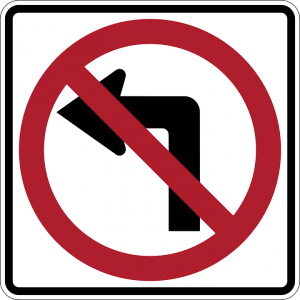 Given their various risks and disadvantages, why not rework intersections to get rid of left turns entirely? It sounds like an improbable solution, but that is precisely the thinking behind the Michigan Left (also known as a “boulevard turnaround” or “Michigan loon” or “ThrU Turn intersection”). In the same left-free family as the “bowtie” and the “jughandle”, this alternative intersection design eliminates lefts at intersections in favor of a U-turn and right turn.
Given their various risks and disadvantages, why not rework intersections to get rid of left turns entirely? It sounds like an improbable solution, but that is precisely the thinking behind the Michigan Left (also known as a “boulevard turnaround” or “Michigan loon” or “ThrU Turn intersection”). In the same left-free family as the “bowtie” and the “jughandle”, this alternative intersection design eliminates lefts at intersections in favor of a U-turn and right turn.
The Michigan Left
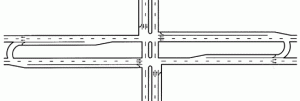 Instead of adding a turn signal phase or forcing drivers to cross oncoming traffic, the Michigan Left sends them right through the intersection. Drivers then turn across the median at a designated spot (generally within a few hundred feet) and wrap back to make a right turn onto their desired road (going the same direction they would as if they had taken a left at the intersection).
Instead of adding a turn signal phase or forcing drivers to cross oncoming traffic, the Michigan Left sends them right through the intersection. Drivers then turn across the median at a designated spot (generally within a few hundred feet) and wrap back to make a right turn onto their desired road (going the same direction they would as if they had taken a left at the intersection).
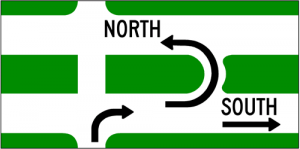
Studies suggest these intersections significantly reduce left-turn collisions, as one might expect. They also reduce the total time needed for traffic light phases and improve pedestrian safety — walkers and cyclists no longer have to worry about drivers failing to notice them while rushing to squeeze in a turn. Of course, Michigan Lefts also increase travel time and distance for left-turning drivers, but this seems a small sacrifice for improved safety.
The Bowtie
The bowtie is basically the same thing as a Michigan Left except that it swaps U-turns for roundabouts on either side of the primary intersection (see also: the “hamburger roundabout“).
Drivers crossing an arterial street from a minor cross street are sent straight through then instructed to circle back via a roundabout on either side of the major-road intersection. To understand why it is called a “bow tie” just rotate the above diagram 90 degrees.
The Jughandle
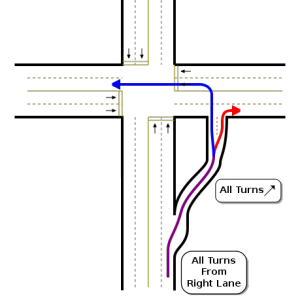
A jughandle intersection (also known as a “Jersey left”*) likewise addresses the left-at-intersection question by avoiding it entirely – one of the multiple configurations of this turn type is shown to the left.
On the plus side, jughandles take left-turning vehicles out of traffic lanes and can break pedestrian crossings into smaller increments (by eliminating left turn lanes). On the downside, this design strategy can confuse drivers and effectively add an additional crossing for pedestrians (where the jughandle rejoins the road). Peer the diagram, it also does not completely eliminate left turns (just moves them out of intersections).
None of these approaches is without its problems — all of them require more space than a conventional intersection and some come with unique dangers. Unfamiliar drivers or pedestrians, for instance, may not know how to handle them at first. Still, where time and space permit, there is something to be said for doing away with left turns.
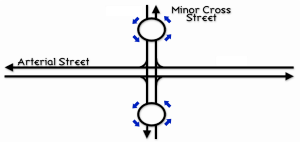



Comments (13)
Share
I think you mean Pittsburgh left, instead of Jersey left when making a left turn immediately upon a signal change to green.
I hate the Michigan left, it’s fundamentally anti-urban because of the crazy amount of right-of-way required. Take a look at any major arterial surface road in the Detroit metro area.
Is there a reason we don’t just use roundabouts to fix this? Beyond, of course, our irrational fear and loathing of roundabouts. The bow tie is particularly perplexing… why build two roundabouts when one larger one would suffice?
Indeed! The bowtie would sort of make sense if there were a bridge in the middle, but as drawn it’s three intersections where one would do. There’s no benefit to the straight across arterial road because they still have to stop at a light to let the minor road cross. I imagine any implementation of this leads to a lot of illegal left turns.
Well, people suck at roundabouting, so my guess is that having one big one would severely interrupt the flow of the arterial.
Roundabouts are brilliant… or they would be if people used them properly.
I used to live in an area with a Michigan Left setup, and I think it worked great at reducing traffic issues…mostly because people do anything to avoid having to drive through it! It is more efficient to take a longer route that stays away from the intersection than to go through the minimum of 3 stoplights necessary to take a left turn! The u-turn specific lanes with u-turn specific stoplights are especially annoying and confusing. I absolutely understand the reasoning behind the intersections, but every time I have to go through it I can’t help but feeling like I’m on candid camera or something.
I’m with Colin Carmichael on this one…what is wrong with roundabouts? Though they initially freak people out, they can’t be any worse than some of the far-less-intuitive designs above.
I spent 2 years living in South Africa. It wasn’t uncommon to have 4- or 5-lane roundabouts. While I think THAT was a bit extreme (having to mandatorily change-lanes in a roundabout always made you question if you were doing it right), 2-lane roundabouts seem to work quite well and are easy to understand…the right lane goes right or straight, the left lane goes straight or left. Easy stuff. And they deal with non-right-angle streets with ease.
If you want a show idea about intersection design, look to the town of Welkom, Free State, South Africa (pronounced “Vel-come”). Pull it up on google maps and zoom it…you’ll notice that EVERY major intersection in town is a roundabout. And this is a fairly good-sized town. From what I remember, there were only 2 traffic lights in the whole town, both for getting on the freeway. When you drive through the town, it definitely FELT very efficient. It was almost exciting in a way…since you rarely have to stop when traversing town, you get this feeling like you are racing or something. Maybe like you are in a game of Mario Kart. I’m sure studies have been down on the town…I think a neat episode would be to look into the design of that town and what we’ve learned from it. Since the town has been like that for ages, I’d assume there are reasons new towns are NOT built like that…I’m just not sure what they are.
The jug handle is more efficient than described when the right exit occurs beyond the intereection, looping back to the arterial, much like a cloverleaf interchange. There are many of these in New Jersey, plus it looks more like a traditional jughandle.
Can’t say I’ve seen one like they picture with those two major roads.
Some are more as you describe (going through, then right to replace a left turn) or, where the side street is a smaller road (rather than the 4 lane/4 lane they picture) the 4 lane road would have a setup as pictured where you break off before the intersection, then can turn right or left at the smaller road (where you only have a smaller amount of traffic to cross the one lane to go left, rather than having to cross the major road turning left).
They both work fine (usually) for the areas they are set up in. The confusion comes when (occasionally) the access ramp occurs far from the actual intersection, allowing you to miss the turn if you don’t expect it so far in advance. Not sure that many are set up that way, though (I can only think of one, but then again that is with a limited amount of areas in the state that we have travelled through).
The Michigan Left diagram looks like the intersection of Massachusetts Ave and Memorial Drive in Cambridge, MA circa 1995, except that it had an underpass for the boulevard (Memorial Drive) going straight so that it didn’t need a light at all except to let people onto Mass Ave during rush hour when there was enough traffic to prevent the side without right-of-way from ever making progress. It was nice, aside from the fact that it was pretty much impossible to explain in signs and if you did anything wrong you’d be stuck going into Boston. Also, if your vehicle was too tall, you had the choice of crashing into the top of the underpass or leaving Cambridge forever. But, hey, it’s great if you know what you’re doing.
The civil eng firm I work for has used Michigan lefts here in San Antonio along Hwy 281 and Loop 1604 as well, but named Superstreets.
Another fun one is the single point urban intersection (with the fantastic acronym SPUI). It’s a crazy way to fix left turns, especially where a freeway intersects a major arterial street. I’ll just say Google it.
I live in São Paulo, Brasil and they use all three of these types of traffic control infrastructure. I don’t know if there are any measurements on efficiency, but I can tell you from personal experience of driving here and in the US for most of my life, it is a better way to manage traffic.
How about you just turn left and don’t hit anyone ?
I read an interesting article somewhere on the Internet, about what the author was very insistent we should call “the modern roundabout” at all times–use of the word modern to avoid ambiguity with devices installed in America that were called roundabouts, but that the author said should be called “traffic circles” instead.
Apparently the latter were marketed as roundabouts, but lacked important features like flared approaches (where there are temporarily more lanes than the highway has), and slip entry and exit (instead the straight highway penetrated the circle abruptly at a right angle, forcing a hard turn), and crucially, gave priority to traffic entering the circle, not to traffic already on the circle.
The chaos this caused, said the author, soured drivers against the whole roundabout concept, unfairly. Admittedly, the modern roundabout uses more right of way than the traffic circle, but I’ve used the former in Europe and the drive feels very smooth.